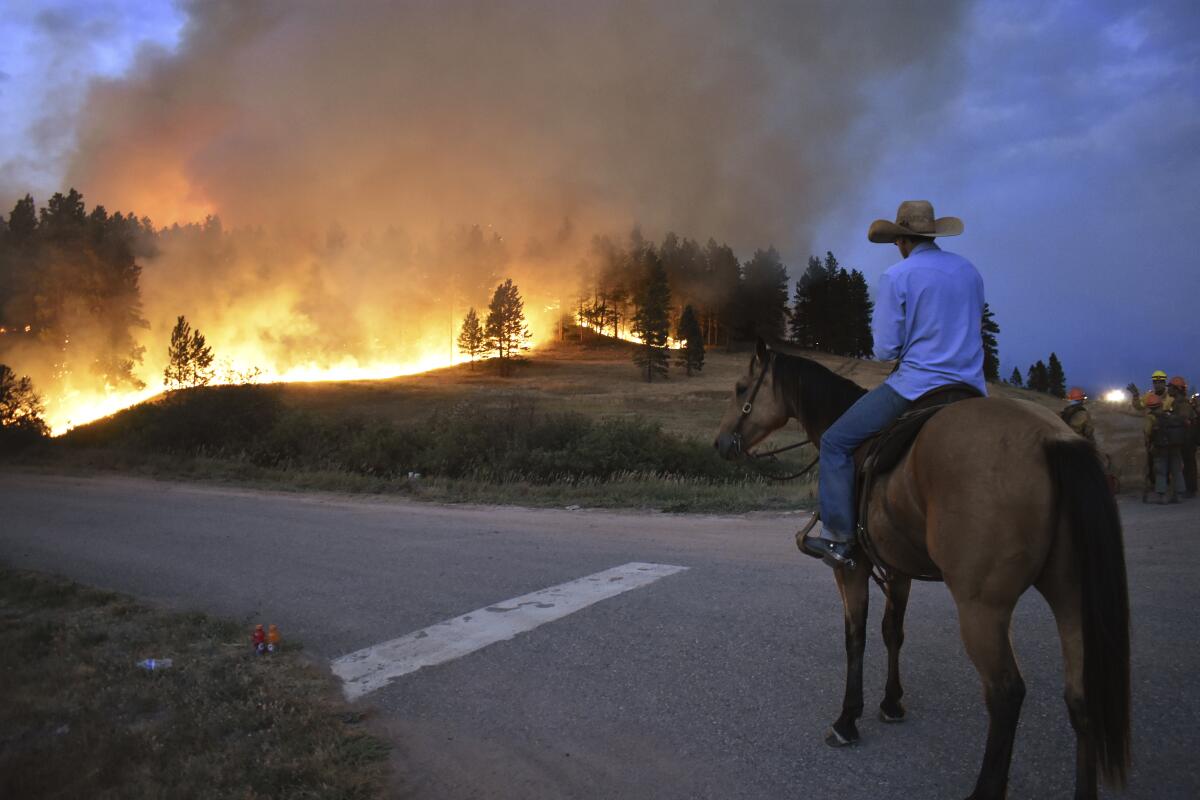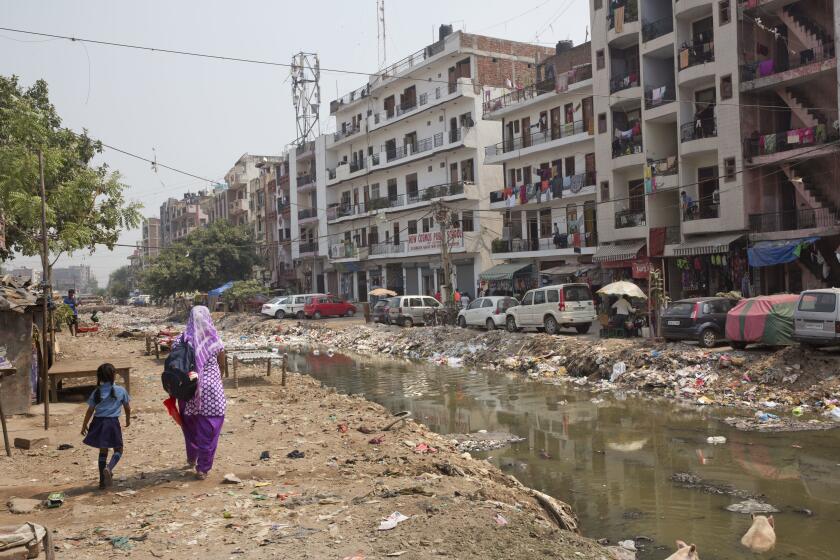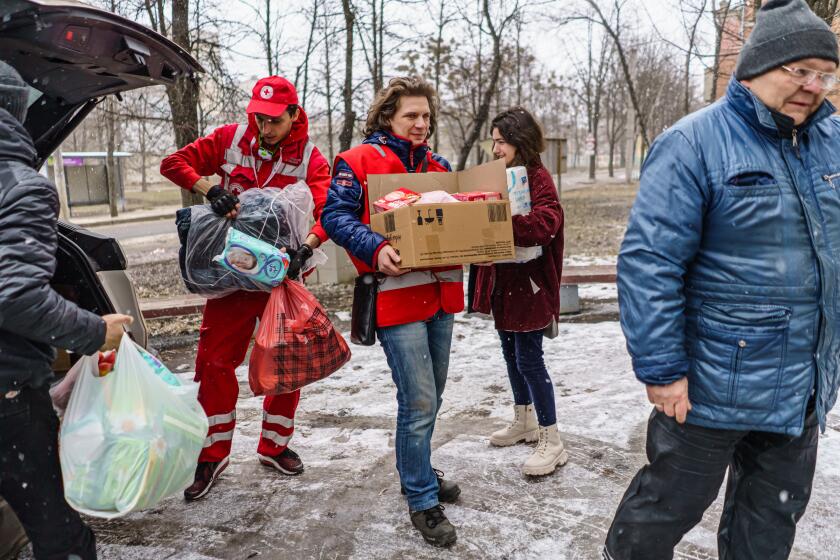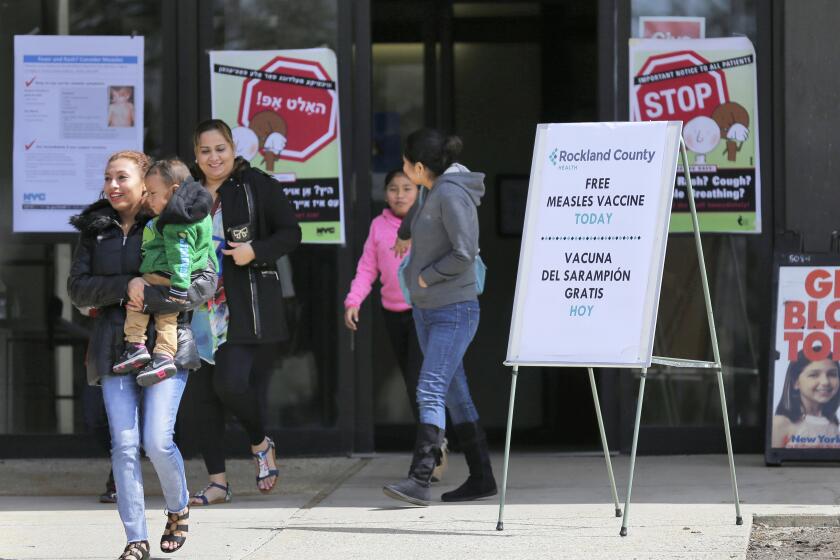Op-Ed: Wildfires have changed. Firefighting hasn’t

- Share via
Already this year, both Colorado and New Mexico have seen the most destructive wildfires in their states’ histories. Colorado’s Marshall Fire consumed almost 1,100 homes in Boulder County. At a time when rooftops and lawns would normally have been covered with snow, drought had left the region dry and vulnerable instead. Erratic wind conditions also contributed to New Mexico’s Hermits Peak Fire. It originated as a prescribed burn to clear out overcrowded trees and dense brush in the Santa Fe National Forest. It was set in early April, when fire and fuel specialists expected lower temperatures and higher moisture levels. But when winds blew embers beyond the project boundary, the burn joined a neighboring fire to become a megafire, eventually burning more than 300,000 acres and forcing waves of evacuations.
Such events reveal profoundly changed conditions on the ground. A recent study found that 1 in 6 Americans are now exposed to “significant” wildfire risk. A host of factors, including a warming climate and intensive development in fire-prone landscapes, exponentially increases our exposure to wildfire risk. This should prompt a reexamination: Does it still make sense to fight wildfires as Americans have for the last century?
Risk factors are together setting the stage for disasters that our present tools are not always able to manage or suppress. The winds that pushed the New Mexico fire beyond control reached 80 mph. Marshall’s topped 115 mph. That’s like a Category 3 hurricane.
In an interview with NPR, Boulder’s wildland fire chief Brian Oliver likened the futility of fighting some wildfires with “trying to fight a hurricane.” I came across this strange comparison often in interviews with wildland firefighters. Frustrated with the perceived pressure to face down fire in a changing landscape of risk, one told me: “We don’t get out in front of hurricanes with fans, trying to change their direction. We don’t get out in front of tornadoes, trying to turn them around.”
Hurricanes and wildfires feed on gradients in temperature, wind speed, atmospheric pressure and humidity. We allow hurricanes to run their course, knowing we can’t change their direction, speed or intensity. But we actively fight wildfires, deploying an underpaid emergency work force, bulldozers, air tankers and other aggressive suppression resources. To many wildfire specialists, sometimes it would make more sense to just get out of the way.
Fire risk has changed, but the public’s expectations about emergency response have not.
The idea that fire can be fought, stopped or metaphorically turned around dates to the early 20th century, when practices of fire suppression evolved, in part, to protect the monetary value of large trees. By 1935, all reported forest fires were to be contained, controlled or put out by 10 a.m. the next day (known as “the 10 a.m. rule,” which is no longer in force). After World War II, the war on wildfire was waged, thanks to the availability of military surplus vehicles, firefighting aircraft and improved road access to facilitate suppression efforts.
Early models of fire behavior focused on controllable wildfires; suppression practices took root before fire spread behaviors were sufficiently understood. For a while, such practices worked. The U.S. Forest Service, the largest employer of wildland firefighters, touts a 98% initial-attack success rate. Yet the initial-attack success rate in the early 20th century, before the introduction of aggressive suppression technologies, was roughly the same (around 97%). The success rate back then was largely because fuel had not accumulated, thanks to “millennia of active burning by Native Americans and natural fires,” in the words of wildfire scientist Mark Finney. As a result, flames were low-intensity and burned low to the ground, “making it easy to achieve a 97% initial-attack success rate” and safer to manage.
Over time, the war on wildfire strengthened the enemy, because successful suppression leaves more and more fuel for larger fires. Success created other risks: As one fire manager told me, “now we’re chasing suppression fires.”
This raises the question: Which fires should actually be fought?
Those that burn under conditions that are relatively safe for firefighters to engage. But fires with such conditions are diminishing. Wildfires affecting more than 100,000 acres (megafires) are now so common that the National Interagency Fire Center “has stopped tracking them as exceptional events.”
Their roving nature, in forested or suburban enclaves, upends preconceptions of which places in the U.S. are vulnerable to fire. Many Americans still want to imagine clear boundaries between fire-safe and fire-prone areas and fund more suppression resources to keep fire out, but fires routinely overrun the fuel breaks meant to control them and firebrands cross over highways, finding their way to and sparking new fires in distant communities. As the Marshall Fire showed, any community “downwind of a grassy area on a windy day … could be vulnerable,” in the words of the mayor of the leveled town of Superior, Colo.
Our mental models of fire are no longer “relevant to the physics of what is actually happening,” in the words of retired U.S. Forest Service fire research scientist Jack Cohen. Fires are best seen not as apocalyptic or inevitable, so much as opportunistic: They burn where they can. Unabated fossil-fuel burning and wishful thinking are opening more pathways for fire. We should own up to these physics while supporting risk mitigation in communities that are most vulnerable to catastrophic loss.
If we understood wildfires to be like hurricanes, we would evacuate as a fire approaches and then return to clean up and maybe rebuild. But we are stuck in the old expectation of fighting fire wherever it “wants” to go, be it in wildlands or densely packed suburbs. Though protecting homes was not supposed to be part of the U.S. Forest Service’s mission. As one former wildland firefighter reminded me, “Fire control people have increasingly become protectors of private properties, infuriating the fire fighters and their agencies.”
The fury seems justified. In the world we have created, a wildfire will go wherever we have allowed fuel to accumulate, whether that fuel is underbrush, logging debris or a vacation home. No army of fire control workers can turn it around, and they shouldn’t have to sacrifice themselves trying.
Adriana Petryna, a professor of anthropology at the University of Pennsylvania, is the author of the recent book “Horizon Work: At the Edges of Knowledge in an Age of Runaway Climate Change.”
More to Read
A cure for the common opinion
Get thought-provoking perspectives with our weekly newsletter.
You may occasionally receive promotional content from the Los Angeles Times.










